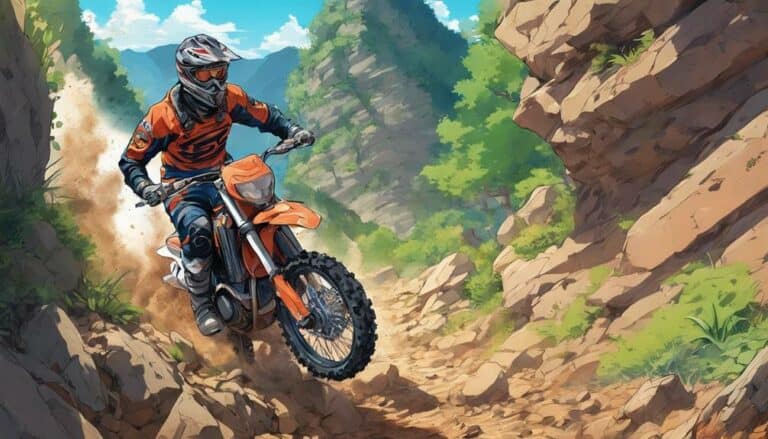When breaking in a dirt bike, riders often face a dilemma: whether to pursue a hard or easy path. The debate between these methods can leave riders wondering which route to take for the ultimate performance of their beloved machine.
So, how do you choose between pushing the limits or taking it slow and steady? The decision might just be the key to unleashing your dirt bike's full potential.
Key Takeaways
- Proper break-in techniques ensure peak performance and longevity of the dirt bike engine.
- Monitoring milestones like the initial 500 miles is crucial for engine adjustments.
- Cooling periods after heat cycles safeguard the engine against overheating and premature wear.
- Post-break-in maintenance, like oil changes and air filter checks, is vital for long-term reliability.
Importance of Break-In Period
During the break-in period of your dirt bike, it's important to follow specific guidelines to secure peak performance and longevity of your machine.
The first ride is more than just a thrilling experience; it's the foundation upon which your engine's future depends.
As you hop on your bike for that initial journey, remember that every twist of the throttle, every shift of the gears, is shaping the very heart of your machine – the engine.
This period isn't the time to hold back but to let your engine feel the freedom of the open road, all while being mindful of the manufacturer's recommendations.
Breaking in your dirt bike's engine properly ensures that the piston and rings seat correctly, setting the stage for best performance down the line.
Embrace this moment of connection with your bike, knowing that your actions today will pave the way for countless adventures to come.
Break-In Techniques for Dirt Bikes
As you prepare to break in your dirt bike, mastering the prime techniques is key to maximizing performance and longevity of your machine. Whether you have a new dirt bike or are looking to optimize an existing one, understanding the importance of heat cycles is critical. When breaking in a new dirt bike, it's recommended to let it idle for short periods initially, allowing the engine components to gradually warm up. This process helps in ensuring proper lubrication and thermal expansion of the engine parts.
Incorporating heat cycles into your break-in routine involves running the engine for short intervals, allowing it to cool down before repeating the process. This method helps in seating the piston rings effectively without putting excessive stress on the engine. Once the initial heat cycles are completed, you can start riding at a moderate pace, combining the benefits of heat cycles with the natural forces experienced during riding to break in your dirt bike engine efficiently. Remember, a well-executed break-in process sets the foundation for an ideal engine performance and durability.
Monitoring Break-In Milestones
Regularly monitoring break-in milestones is essential for optimizing the performance and longevity of your dirt bike engine. When you break in a new dirt bike, the first things to keep an eye on are the initial 500 miles or the first 10 to 20 hours of use. These limits act as a good rule of thumb for ensuring the engine rings and components adjust properly, setting the stage for peak performance and durability.
Cooling Period for Dirt Bikes
For vital engine performance and longevity, ensuring proper cooling intervals is essential when breaking in your dirt bike. Cool down periods between heat cycles aren't just a suggestion; they're a necessity.
Heat is the enemy of your engine during the break-in process, and allowing it to cool after each heat cycle is crucial. This practice helps maintain the ideal operating temperature for all components, preventing overheating and thermal stress on critical parts.
By implementing these cooling periods, you're safeguarding your dirt bike's engine against premature wear and damage. It's not just about getting through the break-in period; it's about setting the foundation for long-term reliability and performance.
Embrace the cooling period as a vital step in conditioning your engine for the adventures that lie ahead. Your dirt bike deserves the care and attention that proper cooling intervals provide.
Post-Break-In Maintenance Tips
Maintain peak performance and prolong your dirt bike's lifespan with these essential post-break-in maintenance tips. After the break-in period, changing the oil regularly is important to keep your engine running smoothly. Checking the air filter and cleaning or replacing it as needed will guarantee performance and prevent debris from entering the engine. Tightening all bolts and performing routine maintenance is essential to prevent issues down the line. By keeping detailed records of engine heat cycles and throttle adjustments, you can track your bike's performance and anticipate any necessary adjustments. Below is a table summarizing these maintenance tips:
| Maintenance Tips | Description |
|---|---|
| Change the Oil | Regular oil changes are important for engine longevity and optimal performance. |
| Check the Air Filter | Monitor and clean or replace the air filter as needed to prevent debris from entering the engine. |
| Tighten all Bolts | Ensure all bolts are securely tightened to prevent issues during rides and prolong the bike's life. |
Conclusion
In summary, breaking in your dirt bike properly is essential for its long-term performance. Whether you choose a hard or easy break-in method, ensuring the engine is warmed up and following proper procedures is key.
Did you know that a well-executed break-in can increase the lifespan of your engine by up to 20%? So, take the time to break in your dirt bike correctly and enjoy peak performance for years to come.

